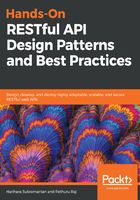
Beginning with REST
So far, we have looked at ROA and a set of guidelines, such as statelessness, resources, addressability, uniform resources, and so on. Those guidelines are the fundamental implementation of REST architecture. As this book is all about RESTful patterns, we are going to explore more about the REST architectural style in this section.
The REST concepts were submitted as a PhD dissertation by Roy Fielding. The fundamental principle of REST is to use the HTTP protocol for data communication (between distributed hypermedia systems), and it revolves around the concept of resources where each and every component considered as a resource, and those resources are accessed by the common interfaces using HTTP methods:

The preceding diagram shows you where REST stands in the ROA architecture and how it can be accessed by different consumers.
REST is an architectural style and not a programming language or technology. It provides guidelines for distributed systems to communicate directly using the existing principles and protocols of the web to create web services and APIs, without the need for SOAP or any other sophisticated protocols.
The REST architecture is simple and provides access to resources so that the REST client accesses and renders the resources on the client side. In REST style,URI or Global IDs helps to identify each resource. As you know REST uses several resources representations to represent its type such as XML, JSON, Text, images and so on.